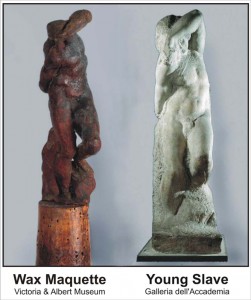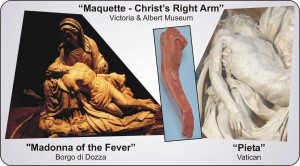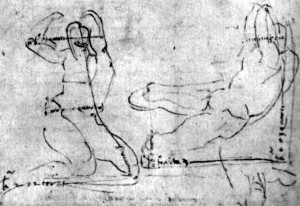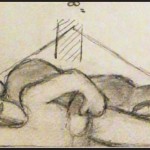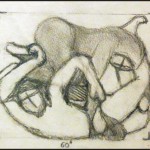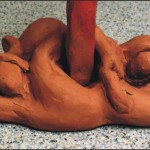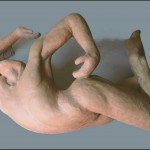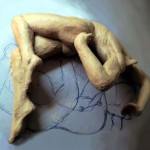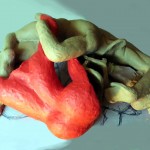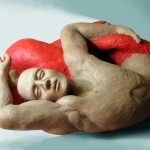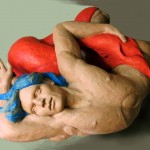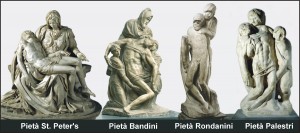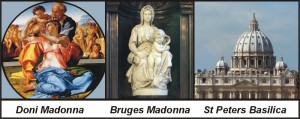Creating your Maquette
Choosing your marble is reminiscent of school yard play…. Finding that precious stone… playing Indiana Jones… But now that you have dusted yourself off and have the block placed in your studio. Its time to get busy.
Designing your masterpiece through pencil and clay sketches is where the true work begins. The ability to discipline yourself to the task of creating a Maquette separates the Master from the Novice. Long before you can apply your muscles to the hammer and chisel, you will need to lovingly caress and model clay.
I know that for many, there will be the temptation to jump right in and start swinging at stone… and for the contemporary artist this may be the best way to coax shapes and curves from the natural grain that the stone presents.
However, if you are interested in realism… in the Renaissance tradition, mastering the maquette is necessary, and if done well, can be financially rewarding.
Michelangelo always made models. In fact, for each scale maquette of a future marble statue, he would additionally create two smaller sketch models (bozzetto). The first as a charcoal sketch, the second in wax or terrasecca (unfired clay)
So important was the modelling process to Michelangelo that he often and publicly lamented on how artist of his generation failed to develop the ability to sketch their work in advance.
It was the model that freed the artist to unbridled natural limitations of fluid form…. The clay body can be torqued to its extremes with confident twists from one angle to the next. Arm back, angled up, torso arched, neck tilted, all in endless manipulations to find that unique final expression.
The artist is freed from bodily limitation… impossible poses can be held indefinitely. This is what gives the stone movement and flight.
Marble carving is unforgiving. As a reductive process, once the stone is removed, there is no going back. A small miscalculation can lead to a change in angle that could throw off the complete symmetry of the final piece.
Michelangelo would create countless limbs in a various poses that could be used over and over again for different statues and frescos. Key sections could be modelled in advance to ensure the supple curves would be carved faithfully to plan.
At this point it would be very easy for us to get down on ourselves for not being as perfect as Michelangelo. Of course there is no such thing as perfection and if you look closely, you can spot hundreds of ‘anomalies’ in the Master’s work. My favourite charcoal sketch of his is the ‘working drawing’ that may have been an early rendering of his masterpiece Night in the Medici Chapel, Florence.
I am sure that Michelangelo would have been mortified for this rough sketch to be viewed publicly. After all, he was careful to destroy the bulk of his rudimentary work that he thought didn’t represent his talents. But the simplicity of this bozzeto, and the small wax model of the Slave fastened atop a cork, illustrates the point that initial sketches should be done quickly and in free form. Perfection should be reserved for the final Maquette.
And so, after examining my marble block and noting the flaws and determining cut lines, I can lose my inner visioning… What do I see in my stone?
Designing your Maquette
The human body is a wonder to observe. Every fold, bend, curve of muscle reminds us of the miracle of life. Even more interesting and miraculous is the complex nature of human emotion and thought. The slightly raised eyebrow or tilt of the head, subtle changes in gestures are designed to emote feelings.
Michelangelo’s genius was not just found in his unparalleled skills in marble carving, but much more significantly, in his mastery of sculpting the true human fluid form out of unforgiving cold stone.
His Pieta in St Peter’s Basilica, for example, is a timeless masterpiece - not because it stands as a unique example of the Sorrowful Virgin Mother; it was not unique. In fact the ‘Pieta’ or artistic rendering of the crucified Christ and Mary, had been painted and carved for centuries. What makes Michelangelo stand out was his dedication to realism. Realism not seen for over a thousand years, since Roman or Classical times.
And this is my goal; to capture the emotion of the Sorrowful Mary with as much realism that I can muster. Using the example of the Renaissance Master, first to quickly sketch the general shape to ensure that it floats within my marble block, then second, to perfect my larger maquette.
The initial sketches should be done as quick as possible… Focus on the idea in your mind and then just move the pencil…. Remember that Michelangelo burned most of his rough sketches, and never intended anyone to see them… they are fast and disposable. The point is to capture the emotion that you are feeling, not to ensure that you 'colour within the lines'… Go through as many sheets of paper as needed, or pick up some modelling clay or children’s plasticine and just start to pinch and pull until the shape comes to resemble what is in your minds eye. You may laugh at yourself, it may be ugly, but it is the general shape that you are after… feel free to throw the sketch away later…
The quick sketches are important, as the following step is very time consuming. The actual maquette can take weeks to complete… and you do not want to waste a month or more of your time… by following the general proportions of your rough models, you will ensure that you don’t spend countless hours refining your maquette only to find that the torso or limbs extend beyond the marble's dimensions…
Feel free to move between and around the different focal points (Jesus and Mary) The statue should grow as a whole; this allows you to make adjustment as needed to ensure that bodies fit within each other. The goal is to have one homogeneous expression, not two separate statues forced into each other.
Save the details for the last; faces and hands. And remember that this is only a maquette, not the final sculpture, so 90 percent is good enough. Believe it or not, the difference between 90 and 100 percent is double the time.
Perfection is important, but not at this stage…. What you are trying to capture is the emotion, the story you want to express… for now, details are less important.
This polymer statue is only halfway complete. And with so much time invested, I will want to ensure that I save my work. The final marble statue will take significant time to finish and be one-of-a-kind… This smaller modelling maquette affords a unique opportunity. Not only will it stand as the template for the stone, but it can also be duplicated in terracotta or slip clay. There may be only one final marble monument, however, many smaller statues can be produced to help finance the larger project.
Pieta, as an allegorical sculptural theme, examines the human experience of Empathy; the sympathetic understanding of one for another, as uniquely felt by the participant to Christ’s crucifixion. This typically centers on the Virgin Mary, but may focus on others who were swept up in Christ’s passion.
In addition to Michelangelo’s maquettes, the master returned again and again to the Pieta theme with as many as four other unfinished examples. The St Peters Pieta was his most traditional portrayal. However, as Michelangelo aged, his own spirituality deepened and with his Pieta Bandini he had inserted himself within the passion narrative.
What impresses me most of his work is how he captures Life and Death with passion and tenderness. Crucifixion, the most painful and humiliating death, is viewed through a compassionate lens of Faith, Hope, Charity and Love.
Pieta Amare will be a closer look at the Allegory behind the Pieta. The purpose of Passion and Redemption… the central values found within Love.
If its winter, and with the snow on the ground and sub zero temperatures, marble becomes unworkable. In the off season, I turn to new projects or continue to develop older ones. Winter is the perfect time to work on maquette designs that will later be carved into stone.
Whenever I start a new piece, I’m always a little embarrassed on the difficulty I have applying the image of my imagination into anything remotely recognizable to anyone but me. If I close my eyes I can see it… but then, with pencil to paper, brush to canvas or hands to clay there is such a struggle. It takes a real leap of faith to push through this awkward phase. And this is why I always start my projects in complete isolation…. No witness to my failure. I honestly believe that any person out there can create art, if they could only get passed this initial hurtle. Art is created by the sheer will of personality.
Of course some are more talented then others… And Michelangelo was a true master… a Universal Artist.
A Master Painter, Master Sculptor, and Master Architect.
But as I pointed out in my post “The Importance of the Maquette” Michelangelo destroyed all that fell short of perfection. And we are only left with his best works; the legacy of the impossible standard.
I look to his quick sketches and wax abbreviations to remind myself that not all work needs to be finished… when starting a new project, Its best to work fast without too much concern for finished quality… Do the best that you can without loosing any sleep. Push through this awkward phase. destroy it later if you like, and no one will be wiser.
From my small bozzetto I can quickly predict structural problems, proportional issues, size limitations. I can calculate casting requirements, pouring transitions, modelling sequences. More importantly, when I squint my eyes, I can see whether the model’s shape and contours carry the intended emotional movement. Does the form and flow communicate the feelings that motivated me in the first place. For my Pieta Amare, this is the Love that we share. It's much easier to change direction at this early stage... bending the 4 inch model one way or the other until it aligns in tune with your imagination.
Using my quick model, I will be able to scale my Maquette to within a size that will fit into the kiln… limiting the overall height to 25 inches of terrasecca clay. Or no more than 28 inches of wet clay. Pieta Amare will be a complicated assembly of separate pieces and so there is an importance to accurate measurements and calculations…
The heads and hands need to be in scale while separate from the main bodies. This will allow me to cast the plaster mould around hard to reach areas.
The body is then added around the hands and faces… this ensures that both Jesus and Mother Mary’s proportions will match. My original calculations from the bozzetto were close and with a slight twist and angle of the head, a little scraping and pulling.. my Pieta Amare should be the perfect size. You may remember from previous posts, that at this stage, only basic details are necessary… 90 percent is good enough. The final finesse can wait for the pressed clay stage.
The next step is to prepare your plaster mold casting

